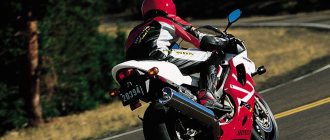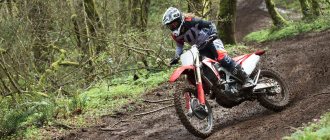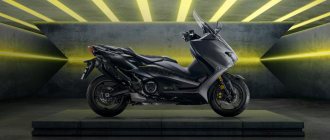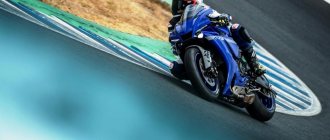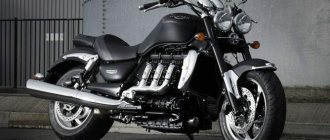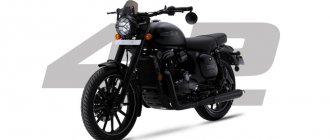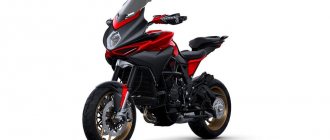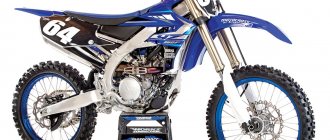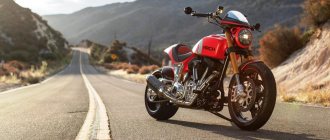Yamaha R7 2022
In 1998, the first YZF-R1 redefined sportsbikes, and since then Yamaha's R series has continued to evolve and expand, not only occupying, but also creating new niches in this field.
Today's R lineup, headlined by the flagship R1M—the most advanced production motorcycle Yamaha has ever built—offers road racing enthusiasts a superb selection of track bikes, including the R1 and R6 RACE, backed by a wide selection of tuning components from the GYTR catalog, allowing achieve even higher levels of engine and chassis performance. At the other end of Yamaha's sportbike spectrum, the twin-cylinder R3 and single-cylinder R125 are the perfect entry into the world of R-models for those new to motorcycling and track riding in particular. The world of motorsports is changing, and while extreme models are in demand among discerning motorcyclists, Yamaha continues to expand its sports line by adding the R7 model, which will help new riders enter the GCMG.
Yamaha R7: with respect to the legend
There is no motorcycle that can be compared to the original Yamaha YZF-R7. This factory race bike could hardly be called a production bike: it was produced in an edition of 500 copies, mainly to qualify it for World Superbike and Suzuka 8 Hours. Ridden by motorsport legends including Noriyuki Haga and Akira Yanagawa, the Yamaha YZF-R7 was considered one of the most exotic and desirable Japanese motorcycles to ever go into production. The new R7 is named after the legend to pay tribute to the original superbike. The 2022 Yamaha R7, proudly bearing the legendary name, is a new breed of sportbike designed for a young audience and designed to attract young riders to the joy of owning and riding a motorcycle of the legendary series.
Growth and obstacles
In 1920, the staff of Nippon Gakki Co. Ltd. There were about 1,000 employees, and the scale of production increased significantly. For example, about 10,000 harmoniums were produced per year. In 1922, the company released its first hand-wound gramophone.
However, the next five years were not so rosy. Due to the rise of the yen, the company lost a large share of its exports, and a fire in factories in 1922 and an earthquake in 23 dealt a serious blow to its financial potential. However, after a series of restoration measures, Nippon Gakki Co. Ltd. continued to stay afloat.
In 1921, on behalf of the government, the company mastered the production of wooden propellers for aircraft, and in the early 30s, under the Nippon Gakki Co. brand. Ltd. metal propellers and other aircraft parts were already produced.
Subsequently, during the Second World War, parts for Zero fighters were produced at Nippon Gakki factories. The experience gained in this way benefited the Japanese company, since it used the studied metal production/processing technologies in the manufacture of frames for its pianos and organs, as well as for the production of wind instruments.
In 1930, engineers at Nippon Gakki Co. Ltd. there was a full-fledged acoustic laboratory. In 1941, the company introduced its first acoustic guitars, and in 1949, shares of Nippon Gakki Co. Ltd. have already been listed on the Tokyo, Osaka and Nagoya stock exchanges.
The world of racing becomes more accessible with the Yamaha R7
The arrival of the new Yamaha R7 makes the world of racing more accessible to many young riders who have discovered a penchant for sportbikes. Based on the incredibly successful and beloved CP2 engine, renowned for its strong linear thrust, reliability and low maintenance costs, this engine is wrapped in a carefully and tastefully engineered hood and fitted with high-quality chassis components, including radial front calipers and a turbocharger. , inverted forks and light-slip slipper clutch, the R7 is a new type of motorcycle that combines the superb performance, superb handling and chic design of the R series with a very competitive price.
Lightweight, compact and nimble, the chic new Yamaha R7 is designed to give riders the highest level of control and maximum wow factor in its class, whether on the track or on the road. But the main thing is that this sportbike is truly accessible to any rider who wants to enter the world of R-series sportbikes. The Yamaha R7 is a new reality and is poised to attract new audiences and influence the sportbike world.
Yamaha R7
The 70s and the “golden” age of Hi-Fi
In 1970, Nippon Gakki Co. Ltd. The wind instrument manufacturing company Nippon Wind Instruments joined, and by the end of the seventies, small wind instrument workshops opened in the capital of Japan and in Hamburg.
By the early 70s, the company mastered the production of microcircuits and built the appropriate facilities for their production. By 1976, a factory was opened producing LSI (large-scale integration, i.e. LSI - “large integrated circuits”).
NS-670
Thanks to LSI, the opportunity to use digital technologies in branded electronic instruments has opened up. Subsequently, a subsidiary company, Yamaha LSI, was formed on the basis of these capacities. The seventies were a turning point for Nippon Gakki Co. Ltd. semiconductor era.
NS-690
In 1972, the NS-600 line of speaker systems was introduced, which in 1973 included top models - massive three-way bookshelf speakers NS-670 and NS-690. For example, the eight-ohm speaker NS-670 had a 250 mm JA-2501A woofer, a 60 mm JA-0601 midrange driver with a dome diffuser, a 30 mm JA-0509 tweeter with a dome membrane, and was designed for 50 W of input power, had dimensions of 320x575x270 mm and weighed 20 kg.
CA-700
In the 72nd Nippon Gakki Co. Ltd. entered the production of component audio equipment and released the CA-700 complete transistor amplifier. The seven hundredth series also included the CA-500 integrated amplifier, CT-700 tuner, YP-700/500 vinyl players and TB-700 cassette deck.
In 1973, the Yamaha CA-1000 integrated amplifier was developed. To transfer to class A there was a corresponding toggle switch on board. The model received an aluminum front panel, and the sides of the case were made of natural wood. The amplifier was designed by GK Design Group.
CA-1000
The power supply contained a massive transformer and two electrolytic capacitors with a capacity of 18,000 uF. Class A delivered 15 W per channel into 8 ohms, while Class B delivered 70 W per channel into 8 ohms. The model used discrete bipolar transistors, an OCL (Output Capacitor-less) output and no microcircuits.
In 1973, a unique aluminum tweeter, the JA-0506, was also released, placed in a small horn, also made of aluminum.
NS-1000M
In 1974, the legendary three-way speaker systems NS-1000M went into production, the characteristic features of which were the use of beryllium dome membranes in the tweeter (33 mm) and midrange driver (88 mm).
Electone CSY-1
Beryllium is lightweight, highly rigid, and provides higher sound propagation speeds than magnesium or titanium. This is a fragile material that is difficult to work with, but the company's engineers used vacuum deposition technology. The 300 mm low-frequency driver had a paper diffuser.
B-1
In fact, the speakers were large monitor-type bookshelf speakers and received high ratings in specialized publications. This was a real breakthrough, since for the first time Japanese speakers competed on equal terms with their Western rivals and eventually became a worldwide hit. In 1976, the NS-1000M was used by the Swedish public broadcasting corporation, and in 1978, the national broadcaster of Finland ordered such speakers.
PM-1000
In 1974, the Electone CSY-1 organ with synthesizer functions was released, as well as the iconic B-1 power amplifier, built on V-FET (Vertical Field-Effect transistor) - polar field-effect transistors with vertical geometry.
In 1975, the first mixing console PM-1000, a pre-amplifier C-1 on field-effect transistors, a top-end vinyl player YP-1000 with a Shure V-15 Type III MM cartridge and a high-end FM tuner CT-7000 appeared in the lineup. which took four years to develop. At the same time, the production of sectional furniture was launched.
CT-7000
CS-80
In 1976, the Yamaha CS-80 synthesizer went into production. At the same time, the C-2 preamplifier, P2200 power amplifier, HP-1 isodynamic headphones and the TC-800GL cassette deck with industrial design, which had a hand in Mario Bellini, were released.
C-2
P2200
In 1976, the next generation of amplifiers appeared, including the CA-1000 III model and the flagship CA-2000, which boasted dial-level signal indicators and Class A operation. The flagship provided power of 120 W per channel (8 ohms, B- class) and 30 W per channel at 8 ohms in A-class.
TC-800GL
CA-2000
In 1977, the CS-80 polyphonic analog synthesizer was released under the Yamaha brand. At the same time, the A-1 amplifier was introduced with a new DC concept (direct current coupling), according to which capacitors were completely eliminated from the signal chain.
A-1
PX-1
In 1978, the PX-1 turntable with a tangential tonearm appeared, the budget NS-451 bookshelf speakers with well-recognized white paper diffusers and the famous NS-10M professional monitors with a closed cabinet, which became an indispensable attribute of almost every recording studio in the world.
NS-10M
The NS-10M was equipped with a 35mm soft dome tweeter and a 180mm mid/bass driver with a ferrite magnet and the same white paper membrane.
A-9
In 1979, Yamaha had a new flagship - the A-9 integrated amplifier, which replaced the CA-2000. In addition to the main features of the previous flagship (the ability to work in the A-class, high power, etc.), the model had five toroidal transformers on board, a good capacitive reserve (four electrolytes of 15,000 uF each), an output impedance control function and Pure Current Servo technology Amp, which maintained a constant current in the power and ground lines, which eliminated their influence on the passing audio signal.
In 1979, the production of a new compact series of keyboard instruments began, called PortaSound.
Yamaha R7 engine
Considering the R7's mission to be accessible and fun, its 689cc CP2 engine is an excellent and well-justified solution. It's been hailed as one of the most characterful, responsive and reliable designs in the class, and it forms the perfect basis for the new model. The CP2 four-stroke inline twin features a 270-degree crankshaft with an unusual firing pattern, dual overhead camshafts and four valves, and a liquid cooling system. It produces powerful, linear thrust over a wide range of rotational speeds, and responds perfectly to the throttle in any gear and at any speed. Peak power of 73.4 hp is achieved at 8750 rpm, and peak torque of 67 Nm occurs at 6500 rpm, giving the Yamaha R7 extremely powerful acceleration both from the start and at high revs, and the unusual rhythm of the 270-degree crankshaft determines unsurpassed pleasure from increasing rotation speed. ECU firmware was created especially for the R7, as well as the intake was optimized, the exhaust tract was improved and the fuel injection system was perfectly tuned. These measures improve handling and result in a smooth but lively throttle response, making the R7 a pleasure to drive no matter the pace, while ensuring compliance with Euro 5 regulations. In addition to these modifications, the R7 received a slightly revised gearbox with a shorter second gear for a sportier character. and powerful acceleration.
Dimensions and weight
The weight of this car is 176 kg, not including fuel. The gas tank volume here is very large for the sports class and is 23 liters. The saddle height is significant: 840 mm. Wheelbase dimensions – 1400 mm. In general, the motorcycle can hardly be called small or, on the contrary, large.
Yamaha R7 clutch
The Yamaha R7's superior handling is enhanced by a new light-slip slipper clutch , which allows for smoother shifts and prevents over-revving the engine and stalling the rear wheel under heavy braking and downshifts, resulting in more predictable and controlled handling in corners. Another benefit of the new clutch is that the lever pull is significantly lighter, approximately 33 percent lighter than a standard clutch.
Quickshifter
Yamaha R7 owners can equip it with a quickshifter, available as an option at Yamaha dealers. This simple but effective device is a limit switch located on the gear shift rod and determines the shift point. When the shift lever is moved up, the ECU relieves power from the transmission for a few milliseconds, allowing for faster, smoother upshifts at full throttle and even more powerful acceleration.
2000s
At the beginning of the new millennium, Shuji Ito, who joined Nippon Gakki in 1965, took over as president of Yamaha Corporation.
In 2001, the record company Yamaha Entertainment Group was founded.
In 2002, Yamaha closed its competition bow business, which it started in 1959.
NS-pf7
In 2003, miniature bookshelf near-field speakers NS-pf7 appeared on the shelves, assembled in convex barrel-shaped enclosures and using 70 mm drivers with a lightweight rigid magnesium membrane. At the same time, the top-end AV receiver Yamaha DSP-Z9 with THX Ultra 2 certification and the YPAO speaker auto-calibration system was introduced.
In 2004, Yamaha began cooperation with Klipsch, a company specializing in the production of acoustic systems. In the same year, Vocaloid software was officially introduced (the word is a derivative of the words “vocal” and “android”), which made it possible to simulate human singing using speech synthesis technology based on a given text and melody.
In January 2005, Yamaha became the owner of the German company Steinberg, which develops software for creating musical works, and in December 2007, Yamaha bought all the shares of the Austrian piano manufacturer Bösendorfer.
YPG-625
In 2007, the Yamaha YPG-625 digital piano received prestigious awards (“Keyboard of the Year” and “Product of the Year”) from the specialized publication The Music and Sound Retailer.
Tenori-on
In the same year, the Yamaha Tenori-on (“tenori-on”) electronic musical instrument with a grid of LED switches was introduced, the creators of which were Japanese artist Toshio Iwai and Yu Nishibori from the Music and Human division Interface Group (Yamaha Center for Advanced Sound Technology).
In 2010, Yamaha Corporation was noted for its flexible TLF-speaker technology, just 1.5 mm thick, reminiscent of a music poster. The abbreviation TLF stood for Thin, Light, Flexible, i.e. "thin", "light" and "flexible".
In 2014, the American company Revolabs, Inc., whose main activity is related to the development of wireless equipment for conference rooms, came under the wing of Yamaha. In the same year, Yamaha Corporation bought out the Line 6 company, which produces musical instruments (mainly guitars) and equipment for them.
In 2022, the company established the Innovation Center R&D base and acquired the American bass amplifier brand Ampeg.
NS-5000
In 2022, the Yamaha WXA-50 and WXC-50 amplifiers, assembled in all-metal housings and using wireless streaming technology, won the German Design Award 2022. In the same year, the Clavinova digital piano (CSP series) was awarded the Red Dot Award, and the top-end The Yamaha NS-5000 speaker system was highly praised by the jury in competitions such as the iF Design Award, the German Design Award and the Good Design Award.
Introduced in 2016, the NS-5000 three-way speakers build on the legacy of the massive bookshelf speakers of the 1970s, such as the NS-1000M. The membranes of the NS-5000 emitters are made of a special synthetic fiber ZYLON with high strength and elasticity.
A-S1100
Currently, in the Audio & Visual group, in the HiFi Components subsection, Yamaha offers a line of stereo amplifiers that represent a kind of return to Hi-Fi roots, as evidenced by the retro design of these devices.
For example, the Yamaha A-S1100 amplifier, introduced in 2015, looks similar to the devices of the 70s, has dial indicators of signal level and even wooden sides. “With this approach, not only melody, harmony and rhythm are important, but also openness, emotion and groove,” says Hi-Fi chief engineer Kiyohiko Goto.
Yamaha R7 chassis
The compactness and lightness of the Yamaha R7 is ensured by a lightweight spine frame designed for excellent handling and ease of steering. A rigidly mounted aluminum center brace improves handling both on the track and on the road, while the high-strength steel frame uses variable-stiffness tubing in key locations to provide the perfect balance of rigidity.
Fork
Careful attention has been paid to the Yamaha R7's suspension, resulting in excellent fork feedback during cornering and braking, along with stability and excellent grip on the track and twisty roads. Clear and predictable feedback is provided by the upper yoke, made using gravity casting technology, and the lower one, forged. The R7 can be easily customized to suit rider needs and riding conditions, with its inverted 41-split fork featuring spring preload, compression and rebound damping adjusters. At the same time, the left fork leg smoothes out compression, and the right one smoothes out rebound, making adjustments simple and informative. The steering precision and crisp feedback of the R7 fork provide a steep 23.7-degree head angle and 90mm trail, and with a compact 1395mm wheelbase and excellent weight distribution (51 percent of the weight is on the front wheel), the new sportbike is designed for fast and precise performance. turns.
Rear suspension
The Yamaha R7 features a redesigned Monocross linkage suspension with damping characteristics and spring rates designed specifically for the sporty nature of the bike. The shock's horizontal mounting provides optimal weight distribution, and the shock itself has spring preload and rebound damping adjustments, allowing you to tune the R7's chassis to suit your riding conditions.
Thorakusu Yamaha
Torakusu Yamaha was born on May 20, 1851 in the city of Wakayama (Kii Province). Since childhood, he was interested in astronomy and had access to his father's large library on this topic. Later, the young man switched to cars and technology, while simultaneously devoting himself to the study of martial arts, incl. Kendo - fencing with bamboo swords.
Between 1868 and 1889, Japan carried out effective socio-economic, political and military reforms that helped it transform from a backward agrarian state into one of the leading countries in the world. Administration of the state was in the hands of the government headed by the emperor.
This stage in Japanese history was called the Meiji Restoration. At the same time, the progressive achievements of the Western world were massively introduced into the country. Thanks to such active “Westernization”, great potential was opened up, as new highly efficient technologies were intensively borrowed.
Thorakus was attracted by such changes - and he tried to make the most of the opportunities that opened up. In 1871, Torakusu went to Nagasaki to train as a watchmaker under the tutelage of an experienced British engineer, eventually becoming an expert in the field.
Yamaha then switched to medical equipment and went to Osaka to study related technology there, and at the age of 35 he moved to Hamamatsu in the hope of making a career there as a medical equipment repairman.
However, Thorakus plans were not destined to come true, since Hamamatsu turned out to be a small provincial town, where earning a living in this way was quite problematic. Therefore, Yamaha had to use his watchmaking skills and even work as a rickshaw puller for the hospital director.
Thorakusu Yamaha
One day, the leadership of a local elementary school turned to Thoracus with a request to repair a harmonium - an American Mason & Hamlin reed organ in which air is pumped by bellows. There was not a single corresponding master within their small town, and such an instrument was quite expensive at that time. Accepting the offer, Torakusu soon identified the cause of the problem - two broken springs, which he intended to make himself.
For repairs, he rented a small room, enlisting the financial support of school director Toyasaku Fukushima, and hired a colleague from the medical equipment department to help him. The year was 1887. Two months later, Torakusu and a friend made his own harmonium and even presented it at the Ongaku Torishirabejo (Institute of Music, now Tokyo University of the Arts (Faculty of Music)).
To do this, Yamaha and her companion had to cover a distance of 250 km on foot! The path passed through the Hakone mountainous area, and the instrument itself was carried on a pole placed on the shoulders. Now this path is immortalized with a memorial bas-relief.
Local professors did not like the instrument because, according to them, it was poorly thought out and configured incorrectly. However, Thorakusa was invited to attend music lectures for free for a month. After this, he returned to Hamamatsu and designed a second organ, which eventually received high praise. The work was hard, especially the setup. Nevertheless, the result turned out to be quite worthy.
He eventually received an order for seven of these instruments, including one for the governor of Shizuoka Prefecture, and in the spring of 1888, Torakusu used the abandoned Hamamatsu Temple to make organs, using experienced carpenters and cabinetmakers.
“It all started in 1887 when Torakusu Yamaha repaired the reed organ,” says Shuji Ito, former president of Yamaha Corporation. “In this sense, Yamaha was originally a musical instrument company.
To make musical instruments, we had to use woodworking machines. A piano is a very specific product and cannot be made using conventional multi-task machines from other industries and materials designed for other products. As for our company, we did it all ourselves. As a result, we gained good experience."
Landing
The Yamaha R7's sporty riding position is the result of hours of testing by factory team riders, and the clip-ons confirm the model's racing origins. After extensive experimentation with a wide variety of handlebar/seat/peg configurations, the final design was chosen to provide a sporty yet adaptable riding position that allows the body to move freely in a variety of situations, especially on the track and on twisty roads. An important feature is the design of the seat: it tapers at the rider's inner thighs and widens at the rear, providing maximum freedom of movement. The clip-on configuration and position of the footpegs have been carefully thought out to provide a collected riding position for optimal handling and maximum aerodynamic efficiency. The possibility of a tight fit is enhanced by the deeply concave shape of the tank, which allows you to hold on with your knees when braking and turning. The single driver's seat has a step, and on top of the tail there is a passenger section, which can be covered with an optional tail fairing, available from the accessories catalogue.
Foundation of the company
In 1887, Yamaha established his own company, which in 1889 was known as Yamaha Organ Works. The enterprise expanded rapidly and soon became a whole factory with the latest assembly lines. The Japanese Minister of Education personally approached Thorakus Yamaha and invited him to consider the issue of supplying musical instruments to schools. As a result, the Yamaha company sold 250 harmoniums to Japanese schools. After this, the management thought about expanding the range: it was planned to produce grand pianos, upright pianos, xylophones and harmonicas.
In 1892, the firm began exporting reed organs to Southeast Asia, and in 1897, the Nippon Gakki Co. was organized by Thorakus. Ltd. (“Japanese Musical Instruments”) with corporate status and capital of 100,000 yen. The first logo of the brand was a fenghuang with a tuning fork in its beak - a phoenix bird from Chinese mythology, embodying the feminine principle “yin”.
In 1899, Thorakusu went on a five-month tour of the United States to gain experience and visit such famous musical instrument companies as W. W. Kimball and Company, Mason & Hamlin and Steinway and Sons, and already in 1900 Nippon Gakki Co. Ltd. released her first piano. Two years later, the company began producing the first grand pianos. In 1903, the company also began producing furniture. In 1904, Yamaha keyboard instruments were highly praised at the World's Fair held in St. Louis (USA).
In March 1902, Thorakusu Yamaha received the prestigious national award, the Medal of Honor with Green Ribbon, which was given to those who diligently and persistently performed their professional duties and became role models. Torakusu also served as director of the Hamamatsu area railroad, and in 1911 he was elected to the city council and appointed vice-chairman of the council.
Torakusu had an 11-year-old student, Koichi Kawai, whom he taught all the secrets of making musical instruments. Koichi later founded Kawai Musical Instruments, which became a competitor to his teacher's company.
In 1914, the first harmonicas appeared in the Yamaha product range.
The First World War played into the hands of Nippon Gakki Co. Ltd., as during this period a restriction was placed on the import of foreign-made musical instruments into Japan, especially those made in Germany. Therefore, the demand for products from local producers has increased significantly.
In August 1916, at the age of 65, Torakusu Yamaha passed away. After this, Vice President Chiyomaru Amano took over as CEO of the company. At this time, the company’s coat of arms already featured a trio of musical tuning forks crossed like swords.
Dimensions
What makes the Yamaha R7 extremely attractive is that it provides the highest level of handling and control in a variety of situations. The key factor in connecting rider and motorcycle is its compact size, allowing full control. With a curb weight of 188kg and compact proportions, the motorcycle allows even the shortest and most compact riders to handle it, and thanks to its excellent weight distribution, low front end and low moment of inertia, the rider feels full control over the motorcycle, allowing him to improve his skills and gain maximum confidence when riding.
90s
In 1990, the company opened factories for the production of musical instruments in China. At the same time, the AX-2000A amplifier went into production, using in its design an end section with HCA (Hyperbolic Conversion Class A operation) technology. The final and preliminary sections were separated, and the chassis and frame were copper plated.
AX-2000A
In essence, this amplifier was the culmination of technological developments dating back to the 70s and 80s, and demonstrated Yamaha's unwavering belief in pure sound, even in the age of digital technology and AV components.
In 1991, the Active Servo Processing Speaker YST-SD 90 subwoofer was presented at the Museum of Modern Art (MoMA) in New York.
GF-1
In addition, Yamaha engineers introduced a new version of beryllium speaker domes, the surface of which was coated with gold. Such tweeters were used in the GF-1 active speaker system.
GT-CD1
1991 also saw the introduction of the GT-CD1 CD player, which featured a thick-walled wooden top and a cast metal base. The CD drive was “embedded” into a wooden part, a clamp was used to hold the CD, and the device itself weighed 24 kg.
In 1992, Yamaha AV components began to be assembled in Malaysia and Indonesia. In the same year, Seisuke Ueshima became president of Yamaha Corporation.
02R
In 1993, the first piano models appeared with SILENT Piano technology, which used electronic keystroke sensors and made it possible to rehearse even at night thanks to the ability to turn off the mechanics of the acoustic part of the piano or grand piano while maintaining the tactile sensations from pressing the keys. Later, Yamaha used this technology in other musical instruments - drum sets, guitars, violins, cellos, etc.
In 1995, Yamaha released the 02R digital mixer, and in 1998, a landmark event occurred when the technologies used to create the digital sound field processor were applied to multi-channel home theater systems. At the same time, Yamaha returned its logo with three tuning forks framed in a circle.
Body kit
The key to high speed and controllability of any sportbike is maximum aerodynamic efficiency. To achieve this, the front end of the motorcycle must be as compact as possible, and this is where the R7 has a powerful advantage. The CP2 engine is one of the most compact in the 700 cc class, and the minimalist tubular steel chassis makes the Yamaha R7 one of the narrowest in the R range - even narrower than the R3 and R125, and therefore extremely aerodynamically efficient, including with a rider in the saddle. As a result, the incredibly compact front end gives the R7 an impressive appearance while making the most of the engine's resources, making the R7 the fastest model yet powered by the same engine.
80s, Yamaha Corporation
In 1980, the company was noted for the organization of the Piano Technical Academy training center, and in 1981 it introduced the YIS computer system. 1980 also saw the release of the B-6 power amplifier, featuring a unique "pyramid" design and a power supply with highly efficient X-power technology. The model provided power of 200 W per channel into an 8 ohm load.
B-6
In the same year, the NS-690III acoustic system appeared on store shelves, a feature of which was a bass speaker diffuser made of spruce cellulose. This is the type of spruce that was used to make Yamaha pianos.
NS-690III
They also opened a guitar factory in North Hollywood, California, which worked with professional guitarists.
FX-3
In 1981, the massive FX-3 three-way floorstanding speakers were released with a tweeter and midrange unit equipped with beryllium domes. The massive FX-3 woofer had a diameter of 360 mm.
CS01
In 1982, the CS01 synthesizer appeared, as well as the Disklavier piano, a conventional acoustic instrument, to which was added a system consisting of a synthesizer and a device capable of automatically pressing keys.
CD-1
In the same year, the company introduced its first CD player, the Yamaha CD-1, with a drive mechanism that slides out along with the tray. The device had separate power supplies for the digital and analog parts, a glass laser lens and a unique control system.
A-2000
In 1983, the A-2000 complete amplifier appeared, which had two transformers (for class A and AB, respectively), electrolytic capacitors with a total capacity of 220,000 uF and had ZDR technology (the so-called “double class A”, in which the signal was amplified in parallel in class A and AB and combined to eliminate the slightest distortion). The model weighed 26 kg and produced 150 W per channel at 6 ohms and a harmonic distortion coefficient of 0.003%.
Clavinova YP-30
In 1983, another “hit” was released - the Clavinova YP-30 electronic piano, as well as the Yamaha DX7 digital synthesizer, which became a bestseller in the 80s. Between '83 and '87, 160,000 DX7 models were sold. At the same time, a more affordable CD player, the CD-X1, appeared on store shelves.
At the same time, Hiroshi Kawasaki took over as president of the company, and his father became chairman of the board. Due to disagreements that arose between them, some mistakes were made related to the construction of the company's head offices in the USA and Great Britain, as well as the failure to enter the personal computer market.
CD-X1
In 1984, the QX1 sequencer was introduced. In the same year, the company began setting up the production of industrial robots, introducing its first model K-1.
QX1
In 1985, a new generation of CD players, the CD-2000/CD-2000W, appeared, using VMA technology to eliminate vibration.
DSP-1
In 1986, the DSP-1 digital sound field processor began production, which ultimately became the forerunner of modern processors for home theater systems. At the same time, the CDX-2200 CD player with 18-bit DACs appeared, which weighed 15 kg. At the same time, in 1986, PMC1 electronic drums were released.
In 1987, a landmark event occurred: in honor of the centenary of its founding, Nippon Gakki changed its name to Yamaha Corporation and removed the tuning forks from its logo, leaving the pure name “Yamaha.” At the same time, Yamaha Artist Services, Inc centers opened around the world, the purpose of which was to cooperate with cultural and educational organizations in different countries, as well as support young talents. In the same year, Yamaha bought a 51% stake in Korg, its closest competitor in the production of keyboards and various electronic equipment.
K-1X
In 1987, the company released the K-1X and K-1XW cassette decks, which became the final models of the K-1 series launched in 1978.
CDX-2020
In 1988, Yamaha began exporting its first CD-ROM burners. In the same year, the company bought out the American synthesizer manufacturing company Sequential Circuits. In 1988, the CDX-2020 CD player was released with four DACs on board.
Yamaha R7 dashboard
Yamaha R7 dashboard
The compact ergonomics of the sportbike results in a light and small instrument panel with inverse LCD indicators. The panel is perfectly organized, and its readings are perfectly perceived at one glance, which means it does not distract the rider and allows him to concentrate on riding. Among other things, the panel displays a gear indicator, a gear shift prompt, and a quickshifter indicator if equipped.
Technical features of Yamaha R7
- Compact, high-torque 689 cc CP2 engine with cross-shaped crankshaft
- Euro 5 Compliant
- Ultra-compact design
- Aerodynamic hood with aluminum lower part
- High quality inverted 41st fork
- Link rear suspension with new shock absorber
- Light slipper clutch
- Lightweight tubular steel frame with aluminum center brace for rated chassis rigidity
- Rear clip-ons and footrests
- Sporty fit
- Aggressive R-Series design with two LED running lights
- Powerful central LED headlight
- Light alloy 10-spoke wheels
- Radial front calipers with Brembo radial master cylinder
- Sporty ergonomics with LCD instrument panel
- Central M-shaped air intake
- Compact, sculpted 13-litre fuel tank
- Tires size 120/70 front and 180/55 rear
Yamaha R7 colors
The new R7 is available in two color options, which debut the updated design of the entire R series. The first color option is Icon Blue on the upper body elements, lower aluminum panels and wheels, while the sides of the fairing are painted in a contrasting darker matte blue. The engine, some trim elements and the swingarm are painted in Crystal Graphite, emphasizing the power and dynamism of the R7.
The R7 will also be available in Yamaha Black with minimalist graphics and accents. The gloss black finish gives the bike a distinctive sporty look, which is enhanced by the Crystal Graphite paint job on the engine and chassis. The beauty of this simple colorway is that it looks chic with a variety of outfits, highlighting them without distracting from them.
60s
In the late 50s, the company mastered the production of fiber-reinforced polymer FRP (Fiber Reinforced Plastics), and in the early 60s, mass production of goods made from this material began: boats, yachts, skis, bathtubs, etc. Popularly, such a durable and lightweight material was usually called fiberglass.
In 1961, Yamaha began producing aluminum and titanium alloys, and a year later - permalloy (iron-nickel magnetic alloy).
In 1962, the Yamaha Recreation division appeared, specializing in the creation of unique resort complexes designed for sports and musical leisure, and in 1965 the company began producing wind instruments.
In 1967, the NS (Natural Sound) speaker, which was built into the Electone electric organ, was repurposed for hi-fi needs. As a result, the first acoustic systems NS-20 and NS-30 appeared in the branded lineup, equipped with woofers, respectively, JA-5002 (68x50 cm) and JA-6002 (89x63 cm).
NS-30
A midrange driver (30 cm for NS-30, 20 cm for NS-20) and a 50 mm tweeter with a level control were mounted on the opposite side of the speaker cabinets. This unique design ensures excellent directional characteristics and provides high-quality surround sound.
By 1966, Nippon Gakki Co. Ltd. became the world leader in piano production volume, producing 100,000 copies per year. At the same time, Yamaha's European representative office was opened, and the range of musical instruments produced by the company was supplemented with drum kits and electric guitars.
Fans of Yamaha guitars include John Lennon, Paul McCartney, Bob Marley, Brian May, Jimmy Page, Carlos Santana, Bob Seger, Billy Sheehan, Michael Anthony, John Denver, Paul Simon, Bruce Springsteen and James Taylor.
In 1967, production of the famous CF-series concert grand pianos began.
Options and Accessories
The Yamaha Genuine Accessories catalog consists of an ever-expanding list of tuning, protection and aesthetic options designed for both the track and the road. The performance-focused track line includes an Akrapovic titanium exhaust, quickshifter, milled engine covers, and engine and radiator guards. Options for the road include a smaller license plate holder, LED turn signals, a tank trim, and a variety of milled elements, including engine protection.
The Paddock Blue clothing catalog consists of casual clothing in Yamaha style and certified safety equipment.
MyGarage app
Yamaha's MyGarage App is a quick way to build a virtual R7 in your choice of colors and accessories on your smartphone or PC. The app allows you to configure your ideal R7, and the result can be viewed from all angles in a 3D view. MyGarage will tell you what accessories are available and help you select them, and can also send a letter to the Yamaha dealership and place an order to retrofit the motorcycle with the selected options and accessories (in the Russian Federation, of course, this is doubtful).

